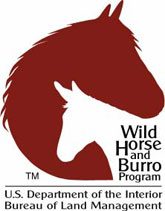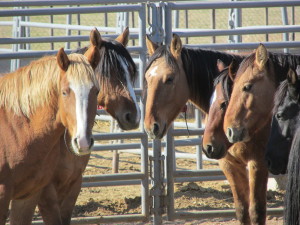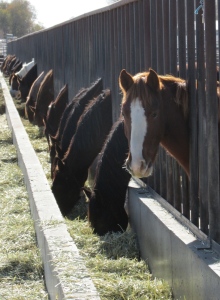Friday, the Wild Horse and Burro Advisory Board, a group charged with making recommendations to the Bureau of Land Management regarding its Wild Horse and Burro program, agreed to potentially euthanize tens of thousands of equines in holding facilities.
Their recommendation undoubtedly hit horse lovers like a bomb. Social media, unsurprisingly, ballooned with immediate rancor.
It’s sad enough that it’s come to this. Read the Elko (NV) news report.
It’s also sad that only a tiny fraction of the public has invested time and thought to understanding this crisis in the American west.
Advisory Board member Ben Masters, who traveled from the Mexican to the Canadian border with three college friends and more than a dozen adopted mustangs (all the subjects of the documentary “Unbranded”), writes with compassion, patience, and reasoning about the situation and how it has come to what on the surface seems like an incredibly horrid state. Read his comments here.
But as horrid as it seems, it’s the best decision the group could make after many, many bad decisions which go back generations. Check out this information graphic to get a better idea of the problems.
Who has led us to this point?
Our forefathers, who thought it was acceptable to turn out unwanted horses to open country. Those domestic horses-turned-wild did too well in the wilderness. The numbers of offspring of former army horses, frontier horses, and ranch horses double every five years.
If they weren’t so pretty, we would call them “invasive” and we would have sought more effective and less emotion-driven, less politicized ways to manage them a long time ago. Is there a romantic term for feral cats? Do you recognize how much damage both feral cats and feral horses do to their environment? For review of mustang crisis.
 Our government, which for decades has rounded up horses and burros, creating more space and available resources for the equines left behind. The BLM strategy, in fact, has had exactly the opposite effect as it intended. The wild populations grew even more. Read more.
Our government, which for decades has rounded up horses and burros, creating more space and available resources for the equines left behind. The BLM strategy, in fact, has had exactly the opposite effect as it intended. The wild populations grew even more. Read more.
Our government has also dragged its feet on pursuing humane population control options, like PZP darting. Instead, it invested in risky, inhumane sterilization procedures (which produced horrible results and subjected the agency to a litany of additional lawsuits) and it continued the round ups.
Activists, some of whom say feral horses and burros have more claim to the land than any other animals. Some believe the equines should live untainted and untethered lives, all other considerations be damned. They leverage romance, old West lore, and widespread ignorance to fan the flames of public outrage.
Ourselves, for failing to get educated on the crisis, for failing to support wild horse trainers, for failing to adopt a mustang or burro, for failing to work towards a research-supported consensus on how to save the equines and the wilderness.
The wild horses and burros are in a fight for their lives, be it on the wild range (where grasslands are collapsing due to their overpopulation) or in the holding pens (where their lives are squandered and they remain ignored by most Americans).
Upset at this current, catastrophic state?
Get educated and try to help. Pause for a moment if you need to cry over damage done. Then let’s work towards a solution.


Lets stop the inhumane sterilization and start PZP darting like mad. No invasive surgery, no need to euthanize once the growing numbers are under control after a few generations we should start to see some results. We will still have feral horses. We will have less horses in holding facilities. Seems a humane and intelligent approach.
It is humans who have ruined everything, we destroy our land, air, water and the beings who inhabit this earth. Shame on US! And the greed that drives humans.
And what of the cattle industry that “leases” PUBLIC land for a pittance and then over grazes it, illegally fences it AND destroys native wildlife that they see as harmful to their profit (pronghorns, wolves, etc.) Yes, the wild horses are an invasive species and should be removed but so are hundreds of thousands of cattle that destroy, destroy, destroy all for a minor amount of money – and that’s even if the ranchers pay the lease fees, think of the Bundy’s. Wild horse protection laws came about because of the inhumane methods use to round up or slaughter the wild herds. The ranchers want the wild horses gone so they manipulate the BLM – which they control – to create a population problem that will result in inhumane irradication. Methods, such as PZP darting, have worked to control other feral animal populations, they would work here, for a fraction of the cost that rounding up and feeding all the “excess” horses have cost. But, that does not create the “crisis” that the ranchers want. The crisis has been carefully created by the ranchers and the BLM.
I agree with and second Liz Morgan who has also posted a comment. As with most crisis situations where natural resources are put in the crosshairs, it’s a “follow the money” game. Nature invariably loses, even when its viability would seem necessary to profits. Those in charge of extraction of virtually any commodity (grazing lands being such a commodity) don’t seem to worry about a resource’s inevitable endgame (since the going business model doesn’t embrace sustainability as too pricey). Even if horses weren’t “competing” for grasslands, it looks like overgrazing would still be the practice, with drought and fire being the great leveler of the playing field.
Do not tell any of us to cry and get over it.
We as humans created this mess. We as humans not heathens need to fix it. Mass murder is not acceptable.
A humane birth control program needs to be implemented immediately. Just because no one knows what to do with these 44,000+ horses in holding does not give us the right to kill them!
What has happened to us, people!!
We need to work. Together. We need to conceive of a solution for protecting those horses in holding. Then move forward.
God forgive us for being such poor stewards of our land and the creatures who live among us.
Do not allow this, people. We have power when we know right from wrong. Those who do not have lost their way. Such shame on you.
JoAnn Foxx
Thank you Maddy for having the verve to bring this to the forefront of your publication. Not a popular topic, there are so many variables at play and the horses are ultimately paying the price.
I have had the honor of having a Sulfur Springs mustang in my life a few years ago, and it changed me forever. There is something about being in the presence of a mustang that is like being in the presence of no other horse. You are exposed something precious and wild, but still with space in his soul to let you in if you earn it.
Like Ben, I will do my small part to help, including having one or more mustangs in my life, and would encourage others to do the same. I am reminded of the Starfish story that goes thus:
A young man is walking along the ocean and
sees a beach on which thousands and thousands
of starfish have washed ashore. Further along
he sees an old man, walking slowly and
stooping often, picking up one starfish after
another and tossing each one gently into the
ocean.
“Why are you throwing starfish into the
ocean?,” he asks.
“Because the sun is up and the tide is going out
and if I don’t throw them further in they will
die.”
“But, old man, don’t you realize there are miles
and miles of beach and starfish all along it!
You can’t possibly save them all, you can’t even
save one-tenth of them. In fact, even if you
work all day, your efforts won’t make any
difference at all.”
The old man listened calmly and then bent
down to pick up another starfish and threw it
into the sea. “It made a difference to that one.”
…and so it is with Mustangs. I will do my best to help when I can and encourage anyone with the skills, ability and resources to do the same.
Thanks Maddy!
Great to hear from you, Rick. Thanks for your valuable comments!
Thank you Maddy for a great article.
Once in a while there are mustang adoption auctions in this area. You have to be certified in order to bid, but the auctions are not well publicized. How is anyone supposed to be able to adopt one of these mustangs? I had hoped to go and find someone who had the facilities to take one in and try to buy and rescue one of these horses but found out about the auction way too late. You have to have fences 6 ft high in order to be eligible to adopt and you must be able to unload the horse in a safe holding area from your trailer. Not many people have these facilities. I have a mustang I bought 16 yrs ago who was already “tamed”. He is the best horse I have ever had. I think it is a shame that someone cannot organize a way for these horses to be trained to lead and perhaps respect a fence. They would then have a better chance of being adopted.
This situation has a long history and many views. It would be very informative to include Ginger Kathryn’s voice as she is also an Advisory Board member.